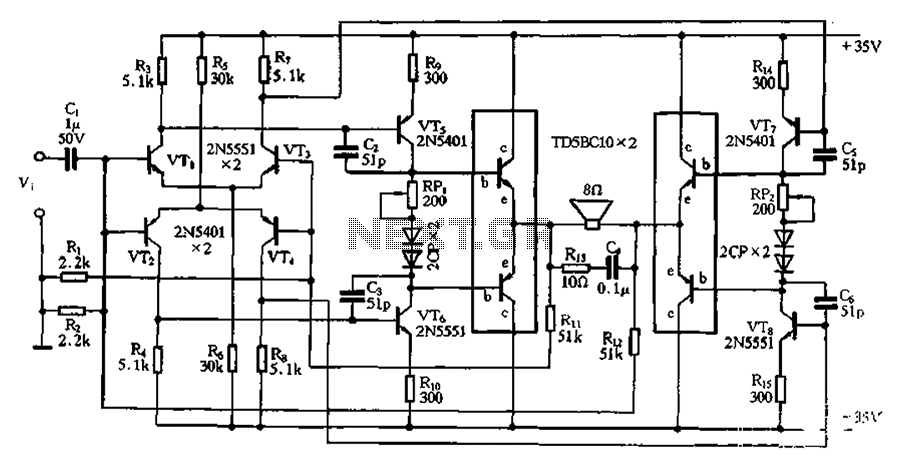
CJ-12 Excitation circuit transfer machine

The CJ-12 Excitation Regulator is designed for automatic excitation control of small generators with a capacity of 250 kW or less. Its circuit is illustrated in Figure 7-45. The adjustment potentiometer RP allows for the modification of the measuring bridge input voltage, which in turn alters the generator's output voltage. This configuration enables a broader phase shift range and can effectively trigger a thyristor rated at 200A.
The CJ-12 Excitation Regulator operates by maintaining the generator output voltage within specified limits, thereby ensuring stable operation under varying load conditions. The core of the circuit consists of a measuring bridge that monitors the output voltage and provides feedback to the control system. The adjustment potentiometer RP plays a crucial role in calibrating the sensitivity of the voltage measurement, allowing the operator to fine-tune the response of the regulator to changes in load.
When the output voltage deviates from the desired setpoint, the regulator responds by adjusting the firing angle of the thyristor. This adjustment is critical for controlling the excitation current supplied to the generator's rotor, which directly influences the magnetic field strength and, consequently, the output voltage. The thyristor, rated at 200A, is capable of handling substantial current loads, making it suitable for this application.
The circuit design includes protective features to prevent over-voltage and over-current conditions. Additionally, the use of feedback loops ensures that the system can quickly respond to fluctuations, maintaining voltage stability. The overall design philosophy emphasizes reliability and ease of adjustment, making the CJ-12 Excitation Regulator an effective solution for small generator applications. CJ-12 Excitation regulator is suitable for a capacity of 250kW or less automatic excitation device small generators. Its circuit is shown in Figure 7-45. Adjustment potentiomet er RP, can change the measuring bridge input voltage, and thus change the output of the generator voltage. This triggers a larger phase shift range, can trigger thyristor 200A.
The CJ-12 Excitation Regulator operates by maintaining the generator output voltage within specified limits, thereby ensuring stable operation under varying load conditions. The core of the circuit consists of a measuring bridge that monitors the output voltage and provides feedback to the control system. The adjustment potentiometer RP plays a crucial role in calibrating the sensitivity of the voltage measurement, allowing the operator to fine-tune the response of the regulator to changes in load.
When the output voltage deviates from the desired setpoint, the regulator responds by adjusting the firing angle of the thyristor. This adjustment is critical for controlling the excitation current supplied to the generator's rotor, which directly influences the magnetic field strength and, consequently, the output voltage. The thyristor, rated at 200A, is capable of handling substantial current loads, making it suitable for this application.
The circuit design includes protective features to prevent over-voltage and over-current conditions. Additionally, the use of feedback loops ensures that the system can quickly respond to fluctuations, maintaining voltage stability. The overall design philosophy emphasizes reliability and ease of adjustment, making the CJ-12 Excitation Regulator an effective solution for small generator applications. CJ-12 Excitation regulator is suitable for a capacity of 250kW or less automatic excitation device small generators. Its circuit is shown in Figure 7-45. Adjustment potentiomet er RP, can change the measuring bridge input voltage, and thus change the output of the generator voltage. This triggers a larger phase shift range, can trigger thyristor 200A.





